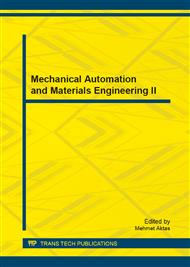p.534
p.539
p.544
p.549
p.554
p.559
p.564
p.569
p.574
The Power Distribution Control Study in Parallel Hybrid Electric Vehicle Based on Fuzzy Theory
Abstract:
By analyzing the parallel hybrid electric vehicle mode, the optimization of output power to fuel engine and electric motor is discussed. The fuzzy logical rules are proposed by fuzzy control theory. According to the system required power and battery SOC, the engine output power and the motor output power are optimized. The results show that the optimization method based on fuzzy logical can effectively reduces fuel consumption and can well control the battery SOC changes.
Info:
Periodical:
Pages:
554-558
Citation:
Online since:
June 2014
Authors:
Keywords:
Price:
Сopyright:
© 2014 Trans Tech Publications Ltd. All Rights Reserved
Share:
Citation:


